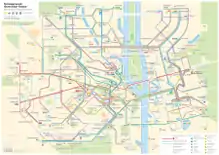Trams in Kyiv
The Kyiv Tram is a tram network that serves the Ukrainian capital Kyiv. The system was the first electric tramway in the former Russian Empire and the fourth one in Europe after the Berlin, Budapest, and Prague tramways. The Kyiv Tram system currently consists of 139.9 km (86.9 mi) of the track,[3] including 14 km (8.7 mi) of two Rapid Tram lines, served by 21 routes with the use of 523 tram cars. However, the system is being neglected, the serviced track length is decreasing at a fast rate and is replaced by buses and trolleybuses.
| Kyiv Tram | |||
|---|---|---|---|
 | |||
| Overview | |||
| Native name | Київський Tрамвай | ||
| Owner | Kyivpastrans, Kyiv City Council | ||
| Area served | Darnytsia Raion, Desna Raion, Dnipro Raion, Holosiiv Raion, Obolon Raion, Pechersk Raion, Podil Raion, Shevchenko Raion, Solomianka Raion, Sviatoshyn Raion | ||
| Locale | Kyiv | ||
| Number of lines | 22 | ||
| Annual ridership | 114,701,800 (2016)[1] | ||
| Website | https://kpt.kyiv.ua/ | ||
| Operation | |||
| Began operation | August 11, 1891 (horse-drawn tram) February 1892 (steam tram) June 13, 1892 (electric tram) | ||
| Number of vehicles | 456 | ||
| Technical | |||
| System length | 230 kilometres (140 mi) (2017)[2] | ||
| Track gauge | 1,524 mm (5 ft) | ||
| |||
The Kyiv Tram system is operated by the "Kyivpastrans" municipal company which also maintains bus, trolleybus, and urban rail transport in Kyiv.
History
During the Russian Empire
_de_la_Ville_de_Kief_1890.jpg.webp)
Before 1886, projects for the construction of a horse-drawn tramway were planned. However, none of these plans had ever proceeded to the construction stage.[4] In 1886, engineer Amand Struve's project was approved for construction, and the Kyiv City Railway Society joint-stock company was founded in 1889.
On June 30, 1891, after the opening ceremony, the first horse-drawn tramcar was set on its track. The official tram operation from Lybidska Square to Mariinsko-Blahovishchynska Street (now Saksahanskoho Street) began on August 11. By August 18, the tram line stretched from Tsar Square (now European Square) to the Demiivska Square.[4] November 7 the Podil tram line from Troyitske Tram Depot (now Podilske Tram Depot) to Oleksandrivska Square (now Contract Square) had been opened.
Soon after tram operations were started, many problems arose. The hilly terrain of Kyiv presented the largest problem. When the Podil line was extended to the Postal Square, a pair of horses was not enough to pull a tramcar uphill. Therefore, another two pairs of horses were added, which did not improve the situation. Thus, mechanizing the tramway by using steam-powered tramway engines was attempted as a solution to the problem. However, the steam engines produced a lot of noise, which scared the horses and people, and produced a lot of air pollution.[4] From September 1891 to February 1892 the line on Oleksandrivskyi Descent (now Volodymyrskyi Descent) had been constructed.
The slew of problems experienced by the trams shocked Struve, who in 1890, had written a letter to the City Administration of Kyiv suggesting that for increased safety and easier use, the trams would need to be powered by electricity.[4] The administration of the Kyiv Telegraph Service opposed this move since, in their opinion, the electric motors would interfere with the telephone and telegraph systems.[4]
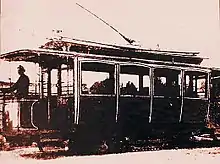
On May 3, 1892, the first two electric trams arrived in Kyiv. They were built by the Struve brothers in a factory located near Moscow, based on American designs. On the same day, the tramcars were tested on the flat Oleksandrivska Street (now Sahaydachnoho Street), and again, on May 8, on the track from Podil Street to Khreshchatyk Street. On June 9 the trams were tested by special commission and began the passenger service on June 13.
In 1893, the money earned by the electric trams exceeded the costs of maintenance. Furthermore, the electric trams were used whenever the horse-drawn or steam-powered trams had difficulty. Nevertheless, the system's horse-drawn trams were in use until 1895, and the last steam-powered cars ran until 1904.
By 1893, the city's trams easily climbed the many steep streets of Kyiv, including Prorizna Street, Kruhlouniversytetska Street and Karavaievska Square (now Square of Ukrainian Heroes). In 1893, the Elektrichestvo journal wrote:
If Kyiv's terrain had not been so unique, then it would have taken many years before electricity would have been used to power the trams.[5]
— Elektrichestvo journal
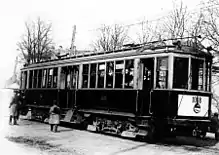
A major problem for the tram drivers at the time was the rolling stock used. When the city's railroad stockholder Lazar Brodsky died, the stock was transferred to a Belgian auction firm, and the tram system began running with Belgian Pullman tramcars with soft, sail-type cloth seats. But neither these, nor the earlier seats on the German tramcars, gave the tram drivers any comfort while standing in wind, rain, or snow, on the driver's platform on the tram.
In 1900 the tram network expanded to Pushcha-Vodytsia. In 1912 long gasoline tram line about 17 versts (18 kilometers) long, was laid from the Postal Square, across the Dnipro river on the Nicholas Bridge, through the Peredmostna and Nikolska Slobodka neighborhoods, and to the neighboring town of Brovary. The line was used until the mid-1930s, and was a single line with passing places. This made the trip seem longer than it really was. The cost was 35 kopecks, a fair amount of money at the time.[4] Nevertheless, the trams were always packed with passengers.
During the Soviet Union
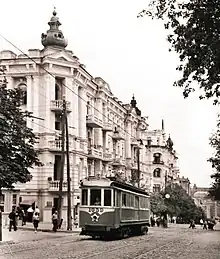
After the Russian Revolution and the Russian Civil War, reconstruction of the tramway system began. Several tram lines had been dismantled and had not been rebuilt. The private-held lines had been connected with the state-owned ones and several new ones were built. In 1924 trams begin to operate at Solomianka, and in 1926 the line at Bulionska Street (now Kazymyra Malevycha Street) was built.
The old and outdated tramcars required restoration as the industry of the country could not manufacture new rolling stock. The reconstruction was carried out in the main tram depot of the system, the Dombal Depot, which would later become the Kyiv Electric Transport Factory. From 1928 to 1932, 80 two-axle motor tramcars and 65 trailer cars were manufactured for Kyiv. From 1932, the depot started producing four-axle tramcars. In these tramcars, the motorman's area was separated from the passenger saloon, but was not warmed during the winter.
In the 1930s, various tram expansion projects were proposed, featuring the lines in Shevchenkivskyi and Solomianskyi Districts, as well as connections with the left bank of the city. Most of the projects were cancelled because of the introduction of the Kyiv trolleybus system, which also caused the dismantling of the tram line in city center.
In 1932 the line at Ivana Fedorova Street had been built. In 1934 the line at Dehtyarivska Street had been opened. In 1935 the tram began to operate at Tymiryazievska Street (now Sadovo-Botanichna Street), as well as the Pechersk line. In 1936 the tram network had reached the Darnytsia Wagon Repair Plant (DVRZ).
In 1941 Nazi Germany attacked the Soviet Union. During the first battle of Kyiv in September, tram operation was stopped. Under Nazi occupation the tram was working intermittently and mostly for freight purposes. During the second battle in 1943 its operation was stopped again. The tram network in the city center incurred heavy damage which would not be restored during the war. After the war the tram was used for garbage removal during the repair works.
In 1951 the tram line at Klovskyi Descent was opened, but other central lines were dismantled around the same time. In 1954 the tram line at Paton Bridge was opened, reconnecting two banks after the war. In 1956 the line at Diahonalna Street (now Leonida Kadenyuka Avenue) was opened. In 1958 the tram began to operate at Kharkivske Highway.
In the 1960s, Soviet Union acquired the tramcars from ČKD, unlike the Soviet ones they only have one cabin which causes the dismantling of many dead-end lines that lasts until the 1980s.
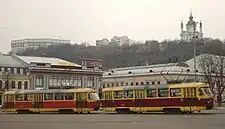
On March 13, 1961, a major landslide hit the city's Podilske Tram Depot, burying it in clay sludge and killing most personnel on site. Additionally, dozens of people died in the tram cars and buses caught by the landslide and subsequent electrical fault and short circuit on the street intersection immediately next to the depot.
In 1961–1968 the tram network was expanded from Dehtiarivska Street to 50th Anniversary of October Avenue (now Vatslava Havela Avenue) at the right bank and from Tashkentska Street to Myropilska Street at the left bank. Several unpopular lines had been closed.
In the 1970s, a tram line had been built at Kurenivka. April 11, 1977 the first line of Kyiv tram had stopped operating. In 1978 a line at Brest-Lytovskyi Avenue (now Beresteiskyi Avenue) was partially dismantled, the remaining part had been operating until 1982.
On December 30, 1978, the first high-speed tram line in the then Soviet Union was opened in Kyiv. It connected the Victory Square (present day Halytska Square) with the Pivdenna Borshchahivka housing estate.[6] The same year Kyiv experienced the peak in tram routes development in its history. In 1978 the length of the lines reached 285 km, the fleet numbered 909 cars, and passenger traffic per year exceeded 396 million people.[7]
In 1980 a tram line through the recently built Obolon neighborhood was built. In 1982 the left bank tram line had been expanded to Mykoly Kybalchycha Street. In 1985 the line at Lesi Ukrainky Boulevard had been closed. In 1986 the second high-speed line was opened at Troieshchyna neighborhood. In 1987 a tram line was opened at newly built Kharkivskyi neighborhood, while the last dead-end line at Lva Tolstoho Street (now Hetmana Skoropadskoho Street) had been dismantled. In 1991 the line at Hoholivska Street was closed.
Routes
As of May 25, 2020, the following routes are in effect:
| Route | Schedule | Terminus | Terminus | Via | Notes |
|---|---|---|---|---|---|
| 1 | Mykhailyvska Borshchavihka | Starovokzalna station |
Symyrenka Street — Koltsova Boulevard — Volodymyra Pokotyla Street — Lesya Kurbasa Avenue — Lyubomyra Huzara Avenue — Borshchahivska Street — Zhylianska Street | Forms part of the Pravoberezhna Line of the Kyiv Light Rail. | |
| 2 | Mykhailyvska Borshchahivka | Kiltseva Road station |
Symyrenka Street — Koltsova Boulevard — Volodymyra Pokotyla Street — Lesya Kurbasa Avenue | Temporarily suspended. Forms part of the Pravoberezhna Line of the Kyiv Light Rail. | |
| 3 | Kiltseva Road station |
Starovokzalna station |
Lesya Kurbasa Avenue — Lyubomyra Huzara Avenue — Borshchahivska Street — Zhylianska Street | Forms part of the Pravoberezhna Line of the Kyiv Light Rail. | |
| 4 | Troieshchyna-2 station |
Myloslavska station |
Onore de Balzaka Street | Forms part of the Livoberezhna Line of the Kyiv Light Rail. Works only on weekdays and in peak hours. | |
| 5 | Troieshchyna-2 station |
Serzha Lyfarya Street | Onore de Balzaka Street — Myloslavska Street — Mykoly Zakrevskoho Street | Forms part of the Livoberezhna Line of the Kyiv Light Rail. | |
| 8 | Perova Boulevard | Pozniaky station |
Suleymana Stalskoho Street — Kurnatovskoho Street — Myropilska Street — Hnata Khotkevycha Street — Pavla Usenka Street] — Ivana Serhienka Street — Kharkivske Highway — Pryvokzalana Street — Yaltynska Street — Slavhorodska Street — Trostyanetska Street — Anny Akhmatovoyi Street — Petra Hryhorenka Avenue | Temporarily changed route during construction on Yuriya Haharina Avenue.[8] | |
| 11 | Yordanska Street | Kontraktova Square | Marshala Malynovskoho Street — Dorbyninska Street — Semena Sklyarenka Street — Kyrylivska Street — Shchekavitska Street (other direction: Olenivska Street) — Kostiantynivska Street (other direction: Mezhyhirska Street) — Spaska Street | Works only on weekdays. | |
| 12 | 14th Lane, Pushcha Vodytsya | Kontraktova Square | Mykoly Yunkerova Street — 5th Lane — Fedora Maksymenka Street — Lisna Highway — Pushcha Vodystka Street — Tarasa Shevchenka Square — Polyarna Street — Avtzavodska Street — Semena Sklyarenka Street — Kyrylivska Street — Shchekavitska Street (other direction: Olenivska Street) — Kostiantynivska Street (other direction: Mezhyhirska Street) — Spaska Street | ||
| 14 | Vidradnyi Avenue | Kontraktova Square | Vidradnyi Avenue — Vatslava Havela Boulevard — Mykoly Vasylenka Street — Dehtyarivska Street — Dmytrivska Street — Hlybochynska Street — Lower Val Street — Kostiantynivska Street (other direction: Mezhyhirska Street) — Spaska Street | ||
| 15 | Vidradnyi Avenue | Starovokzalna station |
Vidradnyi Avenue — Vatslava Havela Boulevard — Mykoly Vasylenka Street — Dehtyarivska Street — Dmytrivska Street — Bulvarno-Kudryavska Street — Zhylyanska Street | ||
| 16 | Heroes of the Dnieper station |
Kontraktova Square | Heroiv Dnipra Street — Zoi Haidai Street — Marshala Tymoshenko Street — Marshala Malynovskoho Street — Dorbyninska Street — Semena Sklyarenka Street — Kyrylivska Street — Shchekavitska Street (other direction: Olenivska Street) — Kostiantynivska Street (other direction: Mezhyhirska Street) — Spaska Street | ||
| 17 | Yordanska Street | 14th Lane, Pushcha Vodytsia | Marshala Malynovskoho Street — Dorbyninska Street — Semena Sklyarenka Street — Avtozavodksa Street — Polyarna Street — Tarasa Shevchenka Square — Pushcha Vodytska Street — Lisna Highway;— Fedora Maksymenka Street — 5th Lane — Mykoly Yunkerova Street | ||
| 18 | Kontraktova Square | Starovokzalna station |
Spaska Street — Mezhyhirska Street (other direction: Kostyantynivska Street) — Lower Val Street (other direction: Upper Val Street) — Hlybochytska Street — Dmytrivska Street — Bulvarno-Kudryavska Street — Zhylyanska Street | ||
| 19 | Kontraktova Square | Tarasa Shevchenka Square | [Spaska Street — Mezhyhirska Street (other direction: Kostyantynivska Street) — Shekavytska Street (other direction: Olenivska Street) — Kyrylivska Street — Semena Sklyarenka Street — Avtozavodska Street — Polyarna Street | ||
| 22 | ZZBK | Perova Boulevard | Boryspilska Street — Pryvokzalna Street — Kharkivske Highway — Ivana Serhienka Street — Pavla Usenka Street — Hnata Khotkevycha Street — Myropilska Street — Kurnatovskoho Street — Suleymana Stalskoho Street | ||
| 23 | DVRZ | Alishera Navoyi Avenue | Almatynska Street — Prazka Street — Azerbaijanska Street — Hnata Khotkevycha Street — Myropilska Street | Temporarily suspended during construction on Almatynska Street. Works only on weekdays. | |
| 25 | Pozniaky metro station |
ZZBK | Anny Akhmatovoyi Street — Petra Hryhorenka Avenue — Trostyanetska Street — Slavhorodska Street — Yaltynska Street — Boryspilska Street | Works only on weekdays. One morning route. | |
| 28 | Myloslavska Street | Darnytske Tram Depot | Mykoly Zakrevskoho Street — Teodora Drayzera Street — Mykoly Kybalchycha Street — Kurnatovskoho Street — Myropilska Street — Hnata Khotkevycha Street — Pavla Usenka Street | Temporarily changed route during construction on Yuriya Haharina Avenue.[8] | |
| 28D | Myloslavska Street | ZZBK | Mykoly Zakrevskoho Street — Teodora Drayzera Street — Mykoly Kybalchycha Street — Kurnatovskoho Street — Myropilska Street — Hnata Khotkevycha Street — Pavla Usenka Street — Ivana Serhienka Street — Kharkivska Highway — Pryvokzalna Street — Boryspilska Street | One morning route. | |
| 29 | Boryspilska station |
Alishera Navoyi Avenue | Tashkentska Street — Kronstadtska Street — Slavhorodska Street — Yaltynska Street — Pryvokzalna Street — Kharkivske Highway — Ivana Serhienka Street — Pavla Usenka Street — Hnata Khotkevycha Street — Myropilska Street — | Temporarily suspended during construction on Yuriya Haharina Avenue.[8] | |
| 32 | Lisova station |
DVRZ | Popudrenka Street — Yuriya Haharina Avenue — Pavla Usenka Street — Ivana Serhienka Street — Prazka Street — Almatynska Street | Temporarily suspended during construction on Almatynska Street. | |
| 33 | Serzha Lyfarya Street | DVRZ | Mykoly Zakrevskoho Street — Teodora Drayzera Street — Mykoly Kybalchycha Street — Kurnatovskoho Street — Myropilska Street — Hnata Khotkevycha Street — Pavla Usenka Street — Ivana Serhienka Street — Prazka Street — Almatynska Street | Temporarily suspended during construction on Almatynska Street. | |
| 33K | Serzha Lyfarya Street | Darnytske Tram Depot | Mykoly Zakrevskoho Street — Teodora Drayzera Street — Mykoly Kybalchycha Street — Kurnatovskoho Street — Myropilska Street — Hnata Khotkevycha Street — Pavla Usenka Street | Temporary route during construction on Amatynska Street.[9] | |
| 35 | Serzha Lyfarya Street | Lisova station |
Mykoly Zakrevskoho Street — Teodora Drayzera Street — Mykoly Kybalchycha Street — Kurnatovskoho Street — Myropilska Street — Hnata Khotkevycha Street — Yuriya Haharina Avenue — Popudrenka Street | Temporarily suspended during construction on Yuriya Haharina Avenue.[8] |
Rolling stock
The Kyiv tram system uses many different tram cars and types, with some being designed in Moscow and manufactured in Riga, some being manufactured by the ČKD Tatra company in Prague, and with some being manufactured right in the city of Kyiv. The following data incorporates only some tram cars used by the system.
Current
| Picture | Manufacturer | Model | Quantity | Since |
|---|---|---|---|---|
.jpg.webp) |
T3SU (3 doors) T3 T3SUCS |
587 10 138 |
1976 2012 2013 | |
.jpg.webp) |
T6B5SU T6B5 |
95 2 |
1985 1994 | |
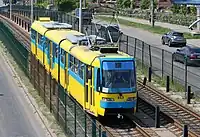 |
KT3UA Kobra T3UA-3 Kashtan |
14 6 |
2004 2012 | |
 |
K1 K1M8 K1M |
9 4 8 |
2010 2010 2012 | |
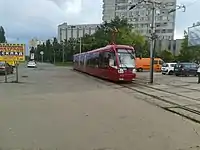 |
TR843 | 1 | 2012 | |
| K3R-NNP Kashtan | 1 | 2013 | ||
 |
T5B64 | 11 | 2015 | |
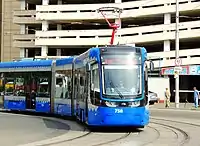 |
71-414 Fokstrot | 57 | 2016 | |
 |
K1M6 | 1 | 2018 | |
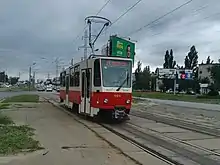 |
T6A5 | 7 | 2019 | |
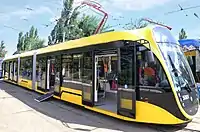 |
K1T306 | 12 | 2021 |
Historical
| Picture | Manufacturer | Model | Quantity | Years |
|---|---|---|---|---|
| 6 | 1892–1909 | |||
| 86 | 1894–1935 | |||
| 6 | 1894–1917 | |||
| 16 | 1899–1917 | |||
| 61 | 1904–1951 | |||
| 129 | 1911–1955 | |||
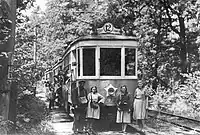 |
Kh M |
49 170 |
1928–1961 1930–1961 | |
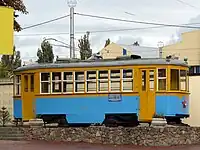 |
2M | 131 | 1930–1955 | |
| M1 | 9 | 1940–1961 | ||
| KTM-1 | 65 | 1948–1966 | ||
| MTV-82 | 260 | 1949–1984 | ||
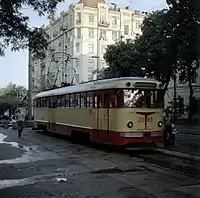 |
KTV-57 | 87 | 1955–1987 | |
| LM-57 | 1 | 1957–1967 | ||
| T2SU | 51 | 1960–1987 | ||
| 6 | 25 | 1962–1969 | ||
| T3SU (2 doors) | 336 | 1964–2011 | ||
| 71-154M-K | 1 | 2010–2017 |
References
- Notes
- Footnotes
- "Головне управління статистики м.Києва - Кількість перевезених пасажирів за видами транспорту (щорічна інформація)".
- Обєкти міського електротранспорту docs.google.com
- For a 2004 plan of the Kyiv tram, please see mashke.org
- Kalachevsky, Vladimir. "The first – in Kiev!". Autocentre (in Russian). Archived from the original on March 11, 2007. Retrieved June 26, 2006.
- Anisimov, Aleksandr (2002). Kyiv and Kyivans (in Russian). Kurch. pp. 88–89. ISBN 966-96120-1-2.
- "Как в Киеве появилась первая в СССР линия скоростного трамвая. Исторические фото: Авто новости от AUTO-Consulting - трамва". www.autoconsulting.ua. Retrieved 2020-05-19.
- "Хрещатик - новини та життя української столиці". Хрещатик (in Ukrainian). Retrieved 2020-05-19.
- "З 28 жовтня орієнтовно до кінця 2020 року рух трамваїв маршруту 35 тимчасово закривається та вносяться зміни в трасу руху трамваїв маршрутів №№ 8, 28, 29". kpt.kyiv.ua (in Ukrainian). Retrieved 2020-11-01.
- "Закривається рух трамваїв №23, 32, 33 - КП Київпастранс". kpt.kyiv.ua. Retrieved 2019-11-10.
- Bibliography
- Mashkevych, Stefan. "In memory of Kiev Trams, by Stefan Mashkevich". Retrieved June 26, 2006.
- Kalachevsky, Vladimir. "The first – in Kiev!". Autocentre (in Russian). Archived from the original on March 11, 2007. Retrieved June 26, 2006.
- Anisimov, Aleksandr (2002). Kiev and Kievans (in Russian). Kurch. pp. 88–89. ISBN 966-96120-1-2.
- Further reading
- Mashkevych, Stefan. Tram Kopecks in Zerkalo Nedeli, October 16–22, 2004. Available in Russian and Ukrainian
- Rozhanovsky, Viktor. Struve: Uphill on the Aleksandrovsky Spusk in Zerkalo Nedeli, October 24–30, 1998. Available in Russian
- Kochevykh, Oleg; Stefan Mashkevich. "Our dear friend the tram". Interesting Kiev (in Russian). Retrieved November 17, 2006.
- Polischuk, Nikolai; Stefan Mashkevich (February 3, 2006). Трамвай, уходящий в чащу. Gazeta po-Kievsky (in Russian).
External links
- "Kyivpastrans" official web site (in Ukrainian and English)
- In memory of Kiev Trams – by Stefan Mashkevich (in English and Russian)
- noosphere.com.ua – Fast tram No.2 in Kyiv (in Russian)
